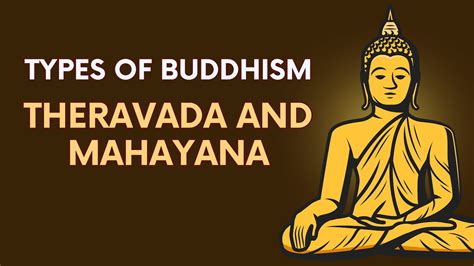Understanding Mahayana and Theravada Buddhism

Diving into the vast and profound world of Buddhism, we often encounter two prominent paths: Mahayana and Theravada. These traditions, though sharing a common origin, have evolved distinctively, offering unique insights and practices. This exploration aims to unravel the core differences and similarities between these two branches, shedding light on their philosophies, practices, and the impact they’ve had on the global spiritual landscape.
Historical Roots and Geographical Spread

Mahayana Buddhism, often referred to as the ‘Great Vehicle’, emerged around the 1st century CE in India. It quickly gained popularity and spread across Asia, influencing cultures in countries like China, Japan, Korea, and Vietnam. The term ‘Mahayana’ signifies a broader, more inclusive path, emphasizing the Bodhisattva ideal—the aspiration to achieve enlightenment for the benefit of all sentient beings.
In contrast, Theravada Buddhism, also known as the ‘Doctrine of the Elders’, is the oldest surviving Buddhist school. Rooted in the teachings of the historical Buddha, Siddhartha Gautama, it traces its lineage back to the 5th century BCE in India. Over time, it became the dominant form of Buddhism in Sri Lanka, Myanmar, Thailand, Cambodia, and Laos. The name ‘Theravada’ implies a commitment to preserving the ancient teachings as they were originally preached.
Scriptural Foundations and Teachings

Mahayana Buddhism is characterized by an expansive body of scriptures, known as the Mahayana Sutras. These texts, written in Sanskrit and later translated into various languages, are considered to be the word of the Buddha, revealed at different times and places. They cover a wide range of topics, from the nature of reality and the path to enlightenment to the role of bodhisattvas and the importance of compassion.
The Heart Sutra, for instance, encapsulates the Mahayana perspective on the emptiness of all phenomena, a concept central to their understanding of the nature of existence.
Theravada Buddhism, on the other hand, draws its scriptural authority primarily from the Pali Canon, the oldest surviving collection of Buddhist texts. The Pali Canon, believed to be a compilation of the Buddha’s teachings as remembered and recited by his early disciples, is divided into three main sections: the Vinaya Pitaka (the monastic code), the Sutta Pitaka (discourses), and the Abhidhamma Pitaka (philosophical treatises).
The Dhammapada, a collection of verses attributed to the Buddha himself, is often regarded as the quintessential Theravada text, encapsulating the essence of the Buddha’s teachings on the path to liberation.
Philosophical and Spiritual Perspectives
Mahayana Buddhism tends to be more philosophically and metaphysically oriented. It posits a vast cosmic hierarchy of buddhas and bodhisattvas, each with their own realm and sphere of influence. The concept of ‘emptiness’ (shunyata) is central to Mahayana thought, suggesting that all phenomena are empty of inherent existence and are interdependent and interconnected.
The notion of the bodhisattva path is a defining feature of Mahayana. A bodhisattva is an enlightened being who delays full Buddhahood to help all sentient beings achieve liberation. This concept emphasizes compassion, wisdom, and the selfless aspiration to benefit others.
Theravada Buddhism, in contrast, is often described as more pragmatic and focused on individual liberation. It emphasizes the Four Noble Truths and the Eightfold Path as the means to achieve Nirvana, the ultimate liberation from suffering. The concept of anatta, or not-self, is central to Theravada, suggesting that there is no permanent, inherent self or soul.
Rituals, Practices, and Daily Life
Mahayana Buddhism is known for its rich and diverse rituals, often involving intricate ceremonies, offerings, and veneration of various buddhas and bodhisattvas. Practices like mantra recitation, visualization of buddhas, and the cultivation of bodhicitta (the mind of enlightenment) are common.
Mahayana temples are often grand and colorful, reflecting the diverse nature of their practices and beliefs.
Theravada Buddhism, while also having its own rituals and ceremonies, tends to be more minimalistic in its approach. Daily practices often involve meditation, chanting, and the study of Buddhist scriptures. The emphasis is on personal practice and the direct experience of the teachings, rather than elaborate rituals.
Theravada temples, though less ornate, are places of profound spiritual practice and contemplation.
Conclusion: A Shared Heritage, Distinct Paths

Despite their differences, Mahayana and Theravada Buddhism share a common heritage, stemming from the teachings of Siddhartha Gautama, the historical Buddha. Both traditions have enriched the spiritual lives of millions, offering unique perspectives on the nature of reality, the path to liberation, and the role of compassion and wisdom in the pursuit of enlightenment.
The choice between these paths often depends on individual preferences, cultural background, and the specific teachings that resonate most profoundly with the seeker. Both traditions continue to thrive, offering ancient wisdom and practical guidance in a modern world.
FAQs: Unraveling Common Queries
What is the core difference between Mahayana and Theravada Buddhism?
+Mahayana Buddhism emphasizes the bodhisattva ideal, compassion, and the concept of emptiness, while Theravada focuses on individual liberation, the Four Noble Truths, and the doctrine of anatta (not-self). Mahayana has a more diverse and expansive scriptural tradition, while Theravada draws its authority from the Pali Canon.
<div class="faq-item">
<div class="faq-question">
<h3>Can someone practice both Mahayana and Theravada Buddhism simultaneously?</h3>
<span class="faq-toggle">+</span>
</div>
<div class="faq-answer">
<p>While it is possible to appreciate and study both traditions, fully practicing both simultaneously can be complex due to their distinct philosophical and ritualistic approaches. Many individuals find their path by resonating with specific teachings and practices from one tradition more than the other.</p>
</div>
</div>
<div class="faq-item">
<div class="faq-question">
<h3>How do Mahayana and Theravada Buddhism view the concept of enlightenment?</h3>
<span class="faq-toggle">+</span>
</div>
<div class="faq-answer">
<p>Mahayana Buddhism sees enlightenment as a collective goal, with bodhisattvas working towards liberating all sentient beings. Theravada, on the other hand, views enlightenment as an individual achievement, with the practitioner striving for Nirvana, the ultimate liberation from suffering.</p>
</div>
</div>
<div class="faq-item">
<div class="faq-question">
<h3>Are there any shared rituals or practices between Mahayana and Theravada Buddhism?</h3>
<span class="faq-toggle">+</span>
</div>
<div class="faq-answer">
<p>While they have distinct practices, both traditions share a common respect for the Buddha and his teachings. Meditation, chanting, and the study of scriptures are fundamental practices in both traditions, though they may be approached differently.</p>
</div>
</div>
</div>



